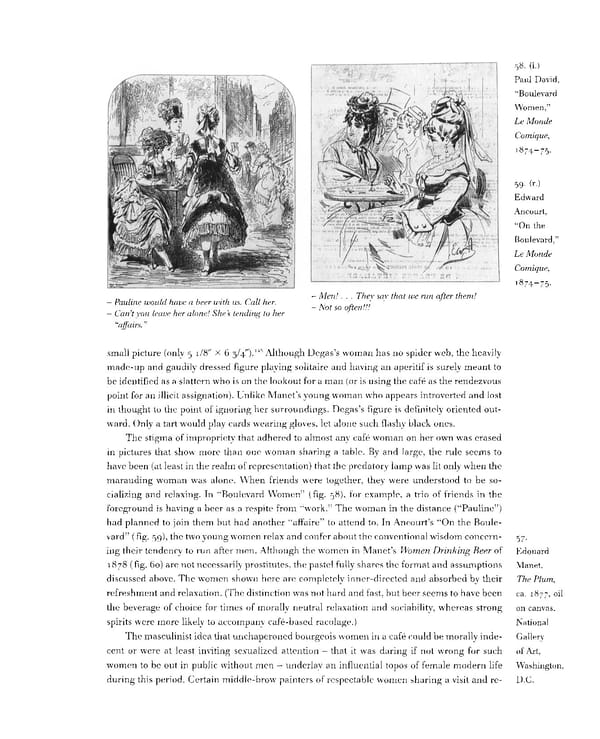58. (1.) Paul David, "Boulevard Women," Le Monde Comique, l8 74~75- r 59- ( -) Edward Ancourt, "On the Boulevard," Le Monde Comique, l8 74~75- - Pauline would have a beer with us. Call her. — Men! . . . They say that we run after them! - Cant you leave her alone! She's tending to her -Not so often!!! <•<• (T ' " affairs. 143 small picture (only 5 1/8" X 6 3/4"). Although Degas's woman has no spider web, the heavily made-up and gaudily dressed figure playing solitaire and having an aperitif is surely meant to be identified as a slattern who is on the lookout for a man (or is using the cafe as the rendezvous point for an illicit assignation). Unlike Manet's young woman who appears introverted and lost in thought to the point of ignoring her surroundings, Degas's figure is definitely oriented out- ward. Only a tart would play cards wearing gloves, let alone such flashy black ones. The stigma of impropriety that adhered to almost any cafe woman on her own was erased in pictures that show more than one woman sharing a table. By and large, the rule seems to have been (at least in the realm of representation) that the predatory lamp was lit only when the marauding woman was alone. When friends were together, they were understood to be so- cializing and relaxing. In "Boulevard Women" (fig. 58), for example, a trio of friends in the foreground is having a beer as a respite from "work." The woman in the distance ("Pauline") had planned to join them but had another "affaire" to attend to. In Ancourt's "On the Boule- vard" (fig. 59), the two young women relax and confer about the conventional wisdom concern- 57- ing their tendency to run after men. Although the women in Manet's Women Drinking Beer of Edouard 1878 (fig. 60) are not necessarily prostitutes, the pastel fully shares the format and assumptions Manet, discussed above. The women shown here are completely inner-directed and absorbed by their The Plum, refreshment and relaxation. (The distinction was not hard and fast, but beer seems to have been ca. 1877, oil the beverage of choice for times of morally neutral relaxation and sociability, whereas strong on canvas, spirits were more likely to accompany cafe-based racolage.) National The masculinist idea that unchaperoned bourgeois women in a cafe could be morally inde- Gallery cent or were at least inviting sexualized attention — that it was daring if not wrong for such of Art, women to be out in public without men — underlay an influential topos of female modern life Washington, during this period. Certain middle-brow painters of respectable women sharing a visit and re- D.C.
 Prostitution & Impressionists Page 121 Page 123
Prostitution & Impressionists Page 121 Page 123